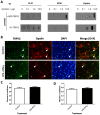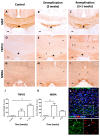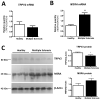TRPV2: A Key Player in Myelination Disorders of the Central Nervous System
- PMID: 35408977
- PMCID: PMC8999035
- DOI: 10.3390/ijms23073617
TRPV2: A Key Player in Myelination Disorders of the Central Nervous System
Abstract
Transient potential receptor vanilloid 2 (TRPV2) is widely expressed through the nervous system and specifically found in neuronal subpopulations and some glial cells. TRPV2 is known to be sensitized by methionine oxidation, which results from inflammation. Here we aim to characterize the expression and regulation of TRPV2 in myelination pathologies, such as hypomyelination and demyelination. We validated the interaction between TRPV2 and its putative interactor Opalin, an oligodendrocyte marker, in mixed glial cultures under pro- and anti-inflammatory conditions. Then, we characterized TRPV2 time-course expression in experimental animal models of hypomyelination (jimpy mice) and de-/remyelination (cuprizone intoxication and experimental autoimmune encephalomyelitis (EAE)). TRPV2 showed upregulation associated with remyelination, inflammation in cuprizone and EAE models, and downregulation in hypomyelinated jimpy mice. TRPV2 expression was altered in human samples of multiple sclerosis (MS) patients. Additionally, we analyzed the expression of methionine sulfoxide reductase A (MSRA), an enzyme that reduces oxidated methionines in TRPV2, which we found increased in inflammatory conditions. These results suggest that TRPV2 may be a key player in myelination in accordance with the recapitulation hypothesis, and that it may become an interesting clinical target in the treatment of demyelination disorders.
Keywords: Opalin; multiple sclerosis; myelination; oxidative stress; recapitulation theory; transient potential receptor vanilloid 2.
Conflict of interest statement
The authors declare no conflict of interest.
Figures







Similar articles
-
Amyloid precursor protein and amyloid precursor-like protein 2 have distinct roles in modulating myelination, demyelination, and remyelination of axons.Glia. 2019 Mar;67(3):525-538. doi: 10.1002/glia.23561. Epub 2018 Dec 2. Glia. 2019. PMID: 30506868
-
A new model of cuprizone-mediated demyelination/remyelination.ASN Neuro. 2014 Sep 30;6(5):1759091414551955. doi: 10.1177/1759091414551955. Print 2014. ASN Neuro. 2014. PMID: 25290063 Free PMC article.
-
EBI2 is expressed in glial cells in multiple sclerosis lesions, and its knock-out modulates remyelination in the cuprizone model.Eur J Neurosci. 2021 Aug;54(3):5173-5188. doi: 10.1111/ejn.15359. Epub 2021 Jul 5. Eur J Neurosci. 2021. PMID: 34145920
-
Nudging oligodendrocyte intrinsic signaling to remyelinate and repair: Estrogen receptor ligand effects.J Steroid Biochem Mol Biol. 2016 Jun;160:43-52. doi: 10.1016/j.jsbmb.2016.01.006. Epub 2016 Jan 14. J Steroid Biochem Mol Biol. 2016. PMID: 26776441 Free PMC article. Review.
-
The neurotoxicant, cuprizone, as a model to study demyelination and remyelination in the central nervous system.Brain Pathol. 2001 Jan;11(1):107-16. doi: 10.1111/j.1750-3639.2001.tb00385.x. Brain Pathol. 2001. PMID: 11145196 Free PMC article. Review.
Cited by
-
Tyrosine phosphorylation and palmitoylation of TRPV2 ion channel tune microglial beta-amyloid peptide phagocytosis.J Neuroinflammation. 2024 Sep 3;21(1):218. doi: 10.1186/s12974-024-03204-6. J Neuroinflammation. 2024. PMID: 39227967 Free PMC article.
-
Multiplexed CRISPRi Reveals a Transcriptional Switch Between KLF Activators and Repressors in the Maturing Neocortex.bioRxiv [Preprint]. 2025 Feb 15:2025.02.07.636951. doi: 10.1101/2025.02.07.636951. bioRxiv. 2025. PMID: 39975013 Free PMC article. Preprint.
-
Roles of TRP and PIEZO receptors in autoimmune diseases.Expert Rev Mol Med. 2024 Apr 25;26:e10. doi: 10.1017/erm.2023.23. Expert Rev Mol Med. 2024. PMID: 38659380 Free PMC article. Review.
-
Micromotion Derived Fluid Shear Stress Mediates Peri-Electrode Gliosis through Mechanosensitive Ion Channels.Adv Sci (Weinh). 2023 Sep;10(27):e2301352. doi: 10.1002/advs.202301352. Epub 2023 Jul 30. Adv Sci (Weinh). 2023. PMID: 37518828 Free PMC article.
References
-
- Fricke T.C., Echtermeyer F., Zielke J., de la Roche J., Filipovic M.R., Claverol S., Herzog C., Tominaga M., Pumroy R.A., Moiseenkova-Bell V.Y., et al. Oxidation of methionine residues activates the high-threshold heat-sensitive ion channel TRPV2. Proc. Natl. Acad. Sci. USA. 2019;116:24359–24365. doi: 10.1073/pnas.1904332116. - DOI - PMC - PubMed
MeSH terms
Substances
Grants and funding
LinkOut - more resources
Full Text Sources
Molecular Biology Databases

